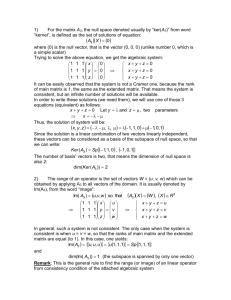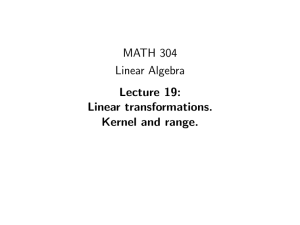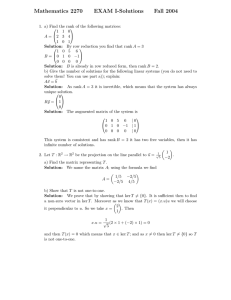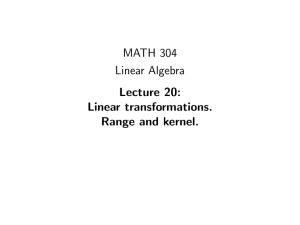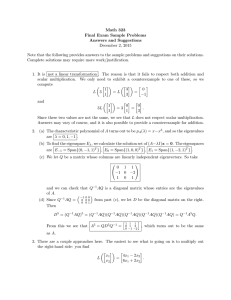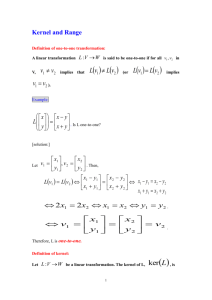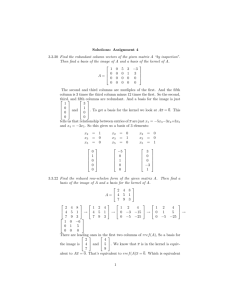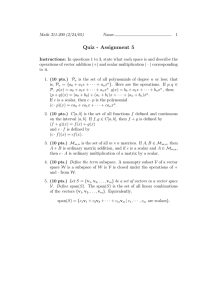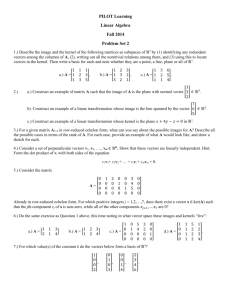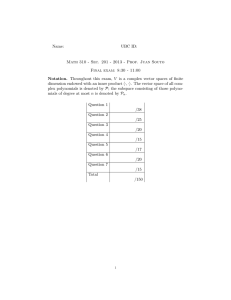PROBLEM SET Assignment 2 Math 5316, Fall 2012 Oct. 25, 2012
advertisement
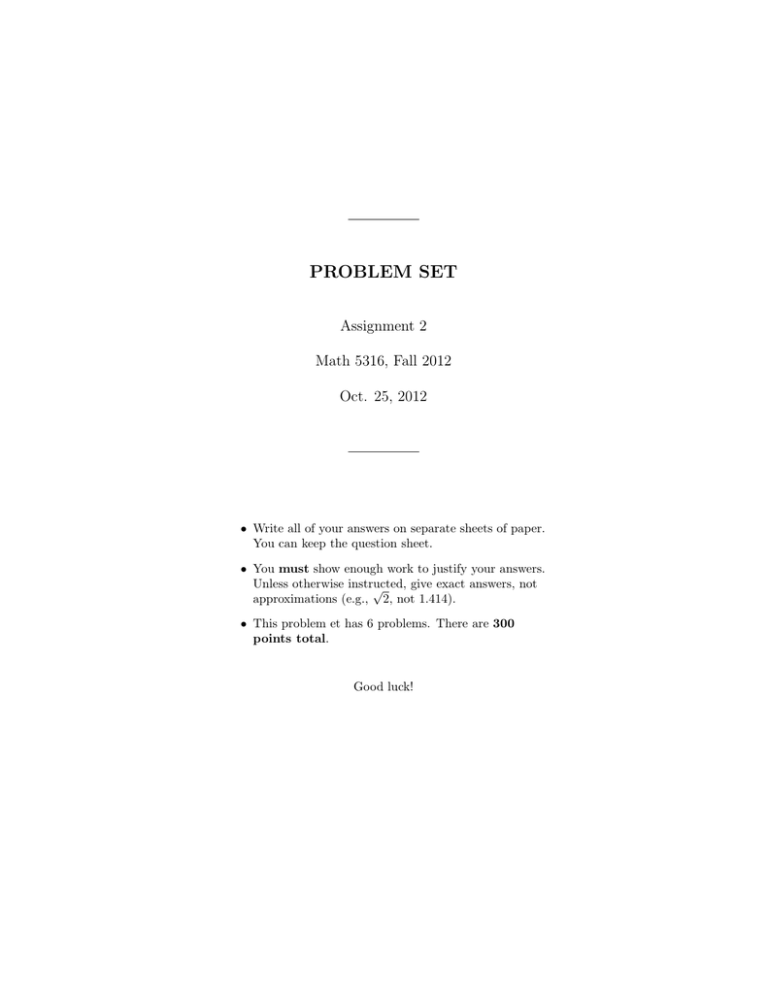
PROBLEM SET
Assignment 2
Math 5316, Fall 2012
Oct. 25, 2012
• Write all of your answers on separate sheets of paper.
You can keep the question sheet.
• You must show enough work to justify your answers.
Unless otherwise instructed,
give exact answers, not
√
approximations (e.g., 2, not 1.414).
• This problem et has 6 problems. There are 300
points total.
Good luck!
Let’s start with some definitions. Let X and Y be sets and let f : X → Y
be a function. If E ⊆ X is a subset of X. We define f (E), the image of E
under f by
f (E) = {f (x) | x ∈ E} = {y ∈ Y | y = f (x)for some x ∈ E}.
In the special case E = X, we call f (X) the image of f , also written as im(f )
If G is a subset of Y , we define f −1 (G), the inverse image of G under f
to be
f −1 (G) = {x ∈ X | f (x) ∈ G}.
In other words, f −1 (G) is the set of all points in X that map into G under f .
Note this makes sense even if the inverse function f −1 does not exist. In the
case of single point y ∈ Y , we often write f −1 (y) instead of the more pedantic
f −1 ({y}).
40 pts.
Problem 1. Let V and W be vector spaces over a field F and suppose that
T: V →W
A. Let X ⊆ V be a subspace of V , show that T (X) is a subspace of W . In the
special case X = V , im(T ) = T (V ) is a subspace of W .
B. Let Y be a subspace of W . Show that T −1 (Y ) is a subspace of V .
60 pts.
Problem 2. Let V be a vectorspace over F and let W ⊆ V be a subspace. If
v ∈ V , we define
v + W = {v + w | w ∈ W },
i.e., all the vectors that we can get by adding a vector in W to v. We call v + W
an affine subspace of V (draw a picture for yourself in the plane). Similarly,
if A, B ⊆ W are any sets, we define
A + B = {a + b | a ∈ A, b ∈ B},
and if λ ∈ F we define
λA = {λa | a ∈ A}.
A. Show that v1 + W = v2 + W if and only if (v1 − v2 ) ∈ W .
B. Show that (v1 + W ) + (v2 + W ) = (v1 + v2 ) + W .
C. Show that λ(v + W ) = λv + W .
1
If V and W are vectorspaces and T : V → W is a linear map, the subspace
ker(T ) = T −1 (0) ⊆ V is called kernel of T . No one will get too upset if you
call it the nullspace. This is the set of all vectors in V that get mapped to 0
by T .
60 pts.
Problem 3. Let V and W be vectorspaces over F and let T be a linear transformation. Let K = ker(T ).
A. Let w be a vector in W and suppose that v0 is a vector in V so that T (v0 ) =
w. Show that T −1 (w) = v0 + K.
B. Show T (v) = T (v0 ) = w ⇐⇒ (v − v0 ) ∈ K ⇐⇒ v + K = v0 + K.
C. Show that T is injective (i.e., one-to-one) if and only if ker(T ) = {0}.
This is the famous business about particular solutions and general solutions.
If T : V → W and we’re trying to solve the inhomogenous linear problem T (v) =
w, we can do it in two steps.
We first find the solutions of the associated homogeneous problem T (v) =
0, i.e., we find ker(T ). If k1 , . . . , kr is a basis of ker(T ) we can think of the
expression h = c1 k1 +c2 k2 +. . . cr kr as the “general solution of the homogeneous
equation,” i.e., it’s a parametrization of ker(T ) that gives us all vectors in ker(T )
as the parameters c1 , c2 , . . . , cr range over F.
Next we find just one vector vp so that T (vp ) = w, i.e., vp is a “particular
solution” of the inhomogenous equation. We can then conclude that
g = vp + h = vp + c1 k1 + c2 k2 + . . . cr kr
is the general solution of the inhomogenous equation, i.e., it’s a parametrization
of the set of solutions of T (v) = w, namely vp + ker(T ).
60 pts.
Problem 4. Let V be a vectorspace over F and let P : V → V be a linear
map so that P 2 = P . Such a linear map is called a projection
operator.
A. Let Q = I − P . Of course P + Q = I. Show that Q is a projection operator
and that P Q = QP = 0.
B. Show that im(Q) = ker(P ) and ker(Q) = im(P ).
C. Show that V = im(P ) ⊕ ker(P ), and that P and Q coincide with the projection operators defined by this direct sum decomposition.
2
40 pts.
Problem 5. Let V and W be vectorspaces over F of the same dimension d,
and let T : V → W be a linear map.
A. Show that if T is one-to-one then it must be onto, so it is an isomophism.
B. Show that if T is onto, it must be one-to-one, so it is an isomophism.
40 pts.
Problem 6. Let V and W be finite dimensional vectorspaces over F and let
T : V → W be a linear map. We don’t assume anything about
the dimensions of V and W .
A. Show that if T is one-to-one then dim(V ) ≤ dim(W ).
B. Show that if T is onto then dim(V ) ≥ dim(W ).
3
